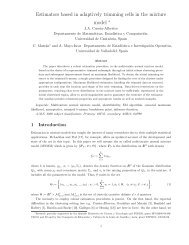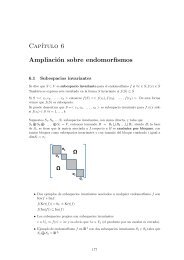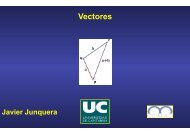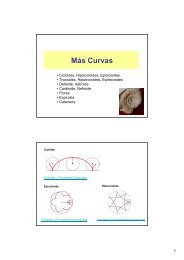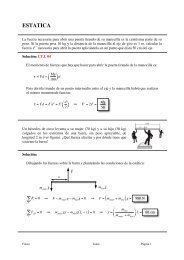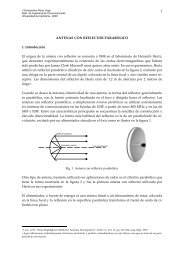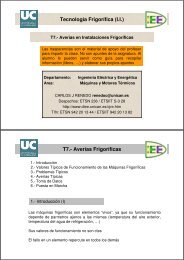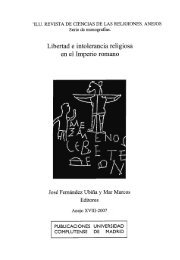Create successful ePaper yourself
Turn your PDF publications into a flip-book with our unique Google optimized e-Paper software.
T2.- Carga Térmica <strong>de</strong> <strong>Refrigeración</strong><br />
3.- Transmisión <strong>de</strong> Calor (XIII)<br />
Normalmente existe una combinación <strong>de</strong> conducción, convección y radiación<br />
Alguno <strong>de</strong> los mecanismos pue<strong>de</strong> ser <strong>de</strong>spreciable<br />
Para una pared plana que separa dos fluidos (radiación <strong>de</strong>spreciable).<br />
t<br />
fi<br />
− t<br />
pi<br />
t<br />
pi<br />
− t<br />
pe t<br />
fi<br />
− t<br />
fe<br />
t<br />
fi<br />
− t<br />
P = = = = fe ;<br />
R<br />
ci<br />
R<br />
k<br />
R<br />
ce<br />
R<br />
ci<br />
+ R<br />
k<br />
+ R<br />
ce<br />
Para aire acondicionado los efectos <strong>de</strong> la convección y los <strong>de</strong> la radiación <strong>de</strong><br />
forma conjunta, la norma ISO<br />
Para tuberías horizontales (0,25 < D < 1 m):<br />
Para tuberías y pare<strong>de</strong>s verticales:<br />
Superficie<br />
Aluminio brillante<br />
Acero galvanizado sucio<br />
A<br />
2,5<br />
5,3<br />
B<br />
2,7<br />
5,5<br />
α = A + 0,<br />
05 ∆t<br />
α = B + 0,<br />
09 ∆t<br />
T2.- Carga Térmica <strong>de</strong> <strong>Refrigeración</strong><br />
3.- Transmisión <strong>de</strong> Calor (XIV)<br />
¿Unida<strong>de</strong>s?<br />
El coeficiente global <strong>de</strong> transmisión <strong>de</strong> calor, K, es el inverso <strong>de</strong> la suma <strong>de</strong><br />
resistencias térmicas consi<strong>de</strong>rando un área <strong>de</strong> transmisión unidad:<br />
1<br />
K =<br />
∑R<br />
R engloba todas las resistencias térmicas existentes.(series y paralelo)<br />
Cuando se trata <strong>de</strong> un tubo, hay que hacer referencia si K está referido al<br />
área interior (K i ) o al área exterior <strong>de</strong>l tubo (K e )<br />
El calor transmitido queda en forma más simplificada:<br />
P = K A ∆t<br />
Se pue<strong>de</strong> hablar <strong>de</strong> la K <strong>de</strong> un edificio (los cerramientos pon<strong>de</strong>rados por su área)



